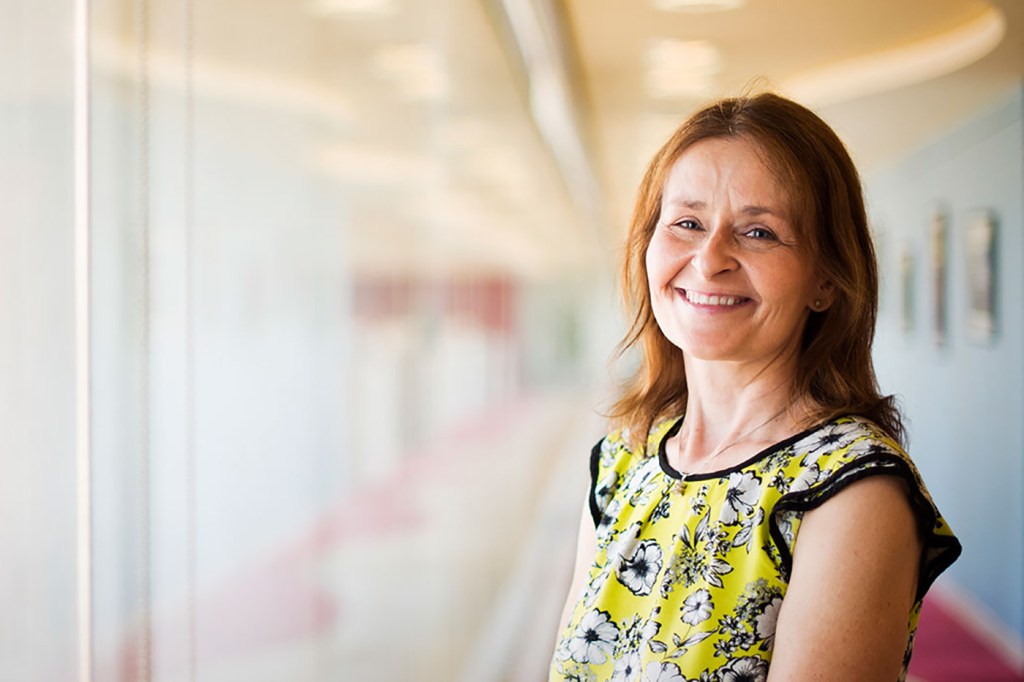Researchers mine ‘a tsunami of free data’ from space

“Man must rise above Earth, to the top of the atmosphere and beyond, for only then will he fully understand the world in which he lives.”
The words belong to Socrates but the person quoting them is Northeastern’s Cordula A. Robinson, associate teaching professor in the Geospatial Information Technology program, an online master’s degree and certificate program launched in 2009.
They eloquently capture why Robinson and her colleagues pursue this line of research. They use sophisticated geospatial mapping software to help analyze masses of data generated from space—images of the Earth’s surface relayed from satellites, drones, and high-flying aircraft—and from the ground to understand how sightings from far-flung locations relate to one another.
Today there is a tsunami of free data—a ‘datanami’—from international space agencies including NASA. The NGA-USGS is looking to Northeastern as a Center of Academic Excellence to help create a structure, a path forward.
— Cordula A. Robinson, associate teaching professor
Last year, the National Geospatial-Intelligence Agency designated Northeastern as one of 17 U.S. Centers of Academic Excellence in Geospatial Sciences. In June, members of the NGA and the U.S. Geological Survey followed up the honor. They came to campus for a site visit, using the Northeastern program as a benchmark for online learning in this very technical field.
Robinson serves as lead faculty of the master’s in GIT as well as two additional offerings: a certificate in geographical information systems and a certificate in remote sensing. Northeastern is one of only two NGA-USGS Geospatial Sciences programs that offer the online master’s.
“Today there is a tsunami of free data—a ‘datanami’—from international space agencies including NASA as well as municipal, state, and federal governments,” says Robinson. “The silo walls have broken down and the floodgates have opened. Education in GIT is in a trailblazing phase. The NGA-USGS is looking to Northeastern as a Center of Academic Excellence to help create a structure, a path forward.”
“A real operational proficiency”
In her own research, Robinson concentrates on the distribution of groundwater in arid and semi-arid lands, most recently Lebanon. She colorfully refers to GIS and the other tools of her trade as “space-age divining rods.” Among the aims of her studies are to track where rain and snow enter and exit mountainous terrain, understand coastal freshwater discharges, and identify sources of marine pollution.
“We’re only part of the story,” she says. “We work with researchers in the field who collect samples as well as local engineers as part of a big interdisciplinary team.” Her findings regarding those water pathways, for example, can guide engineers in developing irrigation systems to capture the water for farming and food.

Satellite image of the Lebanon coast used by Cordula Robinson in her research. It was captured by the Advanced Spaceborne Thermal Emission Reflection Radiometer by NASA in August 2006 and shows the oil slick resulting from damage to the Jiyyeh Power Station. The oil slick appears as a slightly darker shade of blue on the ocean’s surface. Beirut appears as shades of gray, with lines and angles marking the city’s features. Patches of green (vegetation) appear in the Lebanese Mountains to the east. Image by NASA’s Earth Observatory
Given the rapid growth of applications for geospatial intelligence, Robinson is acutely aware of the need for a sophisticated workforce—one that excels in skills from data selection and analysis to information extraction and correlation. “We expect job growth of 27 percent through 2018 in areas such as national security, international humanitarian relief work, disaster response, and logistics management,” she says, ticking off just four possibilities.
“We can get the domestic cream of the crop in terms of instructors because faculty members are not just confined to Boston,” she says of Northeastern’s online program. Some 35 to 50 students from the U.S. and on location in countries as far away as German and Afghanistan register per year, and the numbers are growing.
Students’ capstone projects illustrate the field’s extensive reach. This past year alone they included an analysis of the impact of drought on agricultural farming in California’s San Joaquin Valley; the time, place, and characteristics of serial arson behavior with the goal of mitigating it; and the locations and attributes of fatal car accidents in Boston over an 11-year period with an eye toward preventing such tragedies in the future.
“Ours is a hard-to-obtain skill set – in particular, the techniques for remote sensing and image science — because so far it’s offered primarily in specialized doctoral programs,” says Robinson. “We fill that gap by publicly disseminating master’s and certificate programs online. It’s a new push. People come away with a real operational proficiency and the capability to turn data into actionable knowledge.”





